Dynamic and Energetic Aspects of Carotenoids In-and-Around Model Lipid Membranes Revealed in Molecular Modelling
Abstract
1. Carotenoids: Basic Information
2. The Journey of Carotenoids through the Human Body
3. Carotenoid–Receptor Binding: Molecular-Level Studies
4. Carotenoids: Transfer from Receptor to Membrane
5. Carotenoids in the Membrane: Atomic-Level Motional Studies
6. Carotenoids in the Membrane: A Summary of Computational Studies and Their Significance
Author Contributions
Funding
Acknowledgments
Conflicts of Interest
References
- Fuentes, P.; Pizarro, L.; Moreno, J.C.; Handford, M.; Rodriguez-Concepcion, M.; Stange, C. Light-dependent changes in plastid differentiation influence carotenoid gene expression and accumulation in carrot roots. Plant Mol. Biol. 2012, 79, 47–59. [Google Scholar] [CrossRef]
- Sun, T.H.; Rao, S.M.; Zhou, X.S.; Li, L. Plant carotenoids: Recent advances and future perspectives. Mol. Hortic. 2022, 2, 3. [Google Scholar] [CrossRef] [PubMed]
- Gómez-Sagasti, M.T.; López-Pozo, M.; Artetxe, U.; Becerril, J.M.; Hernández, A.; García-Plazaola, J.I.; Esteban, R. Carotenoids and their derivatives: A “Swiss Army knife-like” multifunctional tool for fine-tuning plant-environment interactions. Environ. Exp. Bot. 2023, 207, 105229. [Google Scholar] [CrossRef]
- Demmig-Adams, B.; Stewart, J.J.; López-Pozo, M.; Polutchko, S.K.; Adams, W.W. Zeaxanthin, a molecule for photoprotection in many different environments. Molecules 2020, 25, 5825. [Google Scholar] [CrossRef] [PubMed]
- Caferri, R.; Guardini, Z.; Bassi, R.; Dall’Osto, L. Assessing photoprotective functions of carotenoids in photosynthetic systems of plants and green algae. In Methods Enzymol; Wurtzel, T.E., Ed.; Academic Press: Cambridge, MA, USA, 2022; Volume 674, pp. 53–84. [Google Scholar]
- Eggersdorfer, M.; Wyss, A. Carotenoids in human nutrition and health. Arch. Biochem. Biophys. 2018, 652, 18–26. [Google Scholar] [CrossRef] [PubMed]
- Milani, A.; Basirnejad, M.; Shahbazi, S.; Bolhassani, A. Carotenoids: Biochemistry, pharmacology and treatment. Br. J. Pharmacol. 2017, 174, 1290–1324. [Google Scholar] [CrossRef] [PubMed]
- Fiedor, J.; Burda, K. Potential role of carotenoids as antioxidants in human health and disease. Nutrients 2014, 6, 466–488. [Google Scholar] [CrossRef] [PubMed]
- Zhao, Z.L.; Chen, J.; Ci, F.F.; Pang, H.; Cheng, N.; Xing, A.J. α-Carotene: A valuable carotenoid in biological and medical research. J. Sci. Food Agric. 2022, 102, 5606–5617. [Google Scholar] [CrossRef] [PubMed]
- Stringham, J.M.; Johnson, E.J.; Hammond, B.R. Lutein across the Lifespan: From Childhood Cognitive Performance to the Aging Eye and Brain. Curr. Dev. Nutr. 2019, 3, nzz066. [Google Scholar] [CrossRef]
- Lopresti, A.L.; Smith, S.J.; Drummond, P.D. The Effects of Lutein and Zeaxanthin Supplementation on Cognitive Function in Adults With Self-Reported Mild Cognitive Complaints: A Randomized, Double-Blind, Placebo-Controlled Study. Front. Nutr. 2022, 9, 843512. [Google Scholar] [CrossRef]
- Parekh, R.; Hammond, B.R.; Chandradhara, D. Lutein and zeaxanthin supplementation improves dynamic visual and cognitive performance in children: A randomized, double-blind, parallel, placebo-controlled study. Adv. Ther. 2024, 41, 1496–1511. [Google Scholar] [CrossRef]
- Yabuzaki, J. Carotenoids Database: Structures, chemical fingerprints and distribution among organisms. Database-Oxford 2017, 2017, bax004. [Google Scholar] [CrossRef] [PubMed]
- Amengual, J. Bioactive Properties of Carotenoids in Human Health. Nutrients 2019, 11, 2388. [Google Scholar] [CrossRef]
- Pitts, S.B.J.; Johnson, N.S.; Wu, Q.; Firnhaber, G.C.; Kaur, A.P.; Obasohan, J. A meta-analysis of studies examining associations between resonance Raman spectroscopy-assessed skin carotenoids and plasma carotenoids among adults and children. Nutr. Rev. 2022, 80, 230–241. [Google Scholar] [CrossRef] [PubMed]
- Fiedor, L.; Dudkowiak, A.; Pilch, M. The origin of the dark S state in carotenoids: A comprehensive model. J. R. Soc. Interface 2019, 16, 20190191. [Google Scholar] [CrossRef] [PubMed]
- Harrison, E.H. Mechanisms involved in the intestinal absorption of dietary vitamin A and provitamin A carotenoids. Bba-Mol. Cell Biol. Lipids 2012, 1821, 70–77. [Google Scholar] [CrossRef]
- Lemmens, L.; Colle, I.; Van Buggenhout, S.; Palmero, P.; Van Loey, A.; Hendrickx, M. Carotenoid bioaccessibility in fruit- and vegetable-based food products as affected by product (micro) structural characteristics and the presence of lipids: A review. Trends Food Sci. Tech. 2014, 38, 125–135. [Google Scholar] [CrossRef]
- Xavier, A.A.O.; Mercadante, A.Z. The bioaccessibility of carotenoids impacts the design of functional foods. Curr. Opin. Food Sci. 2019, 26, 1–8. [Google Scholar] [CrossRef]
- Parker, R.S. Carotenoids.4. Absorption, metabolism, and transport of carotenoids. FASEB J. 1996, 10, 542–551. [Google Scholar] [CrossRef]
- Chacón-Ordóñez, T.; Carle, R.; Schweiggert, R. Bioaccessibility of carotenoids from plant and animal foods. J. Sci. Food Agric. 2019, 99, 3220–3239. [Google Scholar] [CrossRef]
- Reboul, E. Proteins involved in fat-soluble vitamin and carotenoid transport across the intestinal cells: New insights from the past decade. Prog. Lipid Res. 2023, 89, 101208. [Google Scholar] [CrossRef] [PubMed]
- Furr, H.C.; Clark, R.M. Transport, uptake, and target. Tissue storage of carotenoids. In Carotenoids in Health and Disease; Krinsky, N.I., Mayne, S.T., Sies, H., Eds.; Marcel Dekker: New York, NY, USA, 2004; pp. 229–278. [Google Scholar]
- Gugliucci, A. The chylomicron saga: Time to focus on postprandial metabolism. Front. Endocrinol. 2024, 14, 1322869. [Google Scholar] [CrossRef] [PubMed]
- Shmarakov, I.O.; Yuen, J.J.; Blaner, W.S. Carotenoid Metabolism and Enzymology. In Carotenoids and Human Health; Tanumihardjo, S.A., Ed.; Humana Press (Springer): New York, NY, USA, 2013; pp. 29–56. [Google Scholar]
- Canene-Adams, K.; Erdman, J.W., Jr. Absorption, transport, distribution in tissues and bioavailability. In Carotenoids, Nutrition and Health; Britton, G., Liaaen-Jensen, S., Pfander, H., Eds.; Birkhäuser: Basel, Switzerland, 2009; Volume 5, pp. 115–144. [Google Scholar]
- Li, B.X.; Vachali, P.; Chang, F.Y.; Gorusupudi, A.; Arunkumar, R.; Shi, L.J.; Rognon, G.T.; Frederick, J.M.; Bernstein, P.S. HDL is the primary transporter for carotenoids from liver to retinal pigment epithelium in transgenic ApoA-I/Bco2 mice. Arch. Biochem. Biophys. 2022, 716, 109111. [Google Scholar] [CrossRef] [PubMed]
- Arunkumar, R.; Gorusupudi, A.; Bernstein, P.S. The macular carotenoids: A biochemical overview. Bba-Mol. Cell Biol. Lipids 2020, 1865, 158617. [Google Scholar] [CrossRef] [PubMed]
- Krinsky, N.I.; Cornwell, D.G.; Oncley, J.L. The transport of vitamin A and carotenoids in human plasma. Arch. Biochem. Biophys. 1958, 73, 233–246. [Google Scholar] [CrossRef]
- Böhm, V.; Lietz, G.; Olmedilla-Alonso, B.; Phelan, D.; Reboul, E.; Bánati, D.; Borel, P.; Corte-Real, J.; de Lera, A.R.; Desmarchelier, C.; et al. From carotenoid intake to carotenoid blood and tissue concentrations—Implications for dietary intake recommendations. Nutr. Rev. 2021, 79, 544–573. [Google Scholar] [CrossRef] [PubMed]
- Elvira-Torales, L.I.; García-Alonso, J.; Periago-Castón, M.J. Nutritional Importance of Carotenoids and Their Effect on Liver Health: A Review. Antioxidants-Basel 2019, 8, 229. [Google Scholar] [CrossRef]
- Bohn, T.; Desmarchelier, C.; El, S.N.; Keijer, J.; van Schothorst, E.; Rühl, R.; Borel, P. β-Carotene in the human body: Metabolic bioactivation pathways—From digestion to tissue distribution and excretion. P. Nutr. Soc. 2019, 78, 68–87. [Google Scholar] [CrossRef] [PubMed]
- Landrum, J.T. Reactive oxygen and nitrogen species in biological systems: Reactions and regulation by carotenoids. In Carotenoids and Human Health; Tanumihardjo, S.A., Ed.; Humana Press (Springer): New York, NY, USA, 2013; Volume 1, pp. 57–101. [Google Scholar]
- Bandara, S.; von Lintig, J. Aster la vista: Unraveling the biochemical basis of carotenoid homeostasis in the human retina. Bioessays 2022, 44, e2200133. [Google Scholar] [CrossRef]
- Thomas, S.E.; Harrison, E.H. Mechanisms of selective delivery of xanthophylls to retinal pigment epithelial cells by human lipoproteins. J. Lipid Res. 2016, 57, 1865–1878. [Google Scholar] [CrossRef]
- Harrison, E.H. Mechanisms of transport and delivery of vitamin A and carotenoids to the retinal pigment epithelium. Mol. Nutr. Food Res. 2019, 63, e1801046. [Google Scholar] [CrossRef] [PubMed]
- Shen, W.J.; Asthana, S.; Kraemer, F.B.; Azhar, S. Scavenger receptor B type 1: Expression, molecular regulation, and cholesterol transport function. J. Lipid Res. 2018, 59, 1114–1131. [Google Scholar] [CrossRef] [PubMed]
- Yang, J.Y.; Anishchenko, I.; Park, H.; Peng, Z.L.; Ovchinnikov, S.; Baker, D. Improved protein structure prediction using predicted interresidue orientations. Proc. Natl. Acad. Sci. USA 2020, 117, 1496–1503. [Google Scholar] [CrossRef]
- Powers, H.R.; Sahoo, D. SR-B1’s next top model: Structural perspectives on the functions of the HDL receptor. Curr. Atheroscler. Rep. 2022, 24, 277–288. [Google Scholar] [CrossRef]
- Quadro, L.; Giordano, E.; Costabile, B.K.; Nargis, T.; Iqbal, J.; Kim, Y.; Wassef, L.; Hussain, M.M. Interplay between β-carotene and lipoprotein metabolism at the maternal-fetal barrier. Bba-Mol. Cell Biol. Lipids 2020, 1865, 158591. [Google Scholar] [CrossRef] [PubMed]
- Borel, P.; Moussa, M.; Reboul, E.; Lyan, B.; Defoort, C.; Vincent-Baudry, S.; Maillot, M.; Gastaldi, M.; Darmon, M.; Portugal, H.; et al. Human plasma levels of vitamin E and Carotenoids are associated with genetic polymorphisms in genes involved in lipid metabolism. J. Nutr. 2007, 137, 2653–2659. [Google Scholar] [CrossRef] [PubMed]
- Reboul, E. Mechanisms of carotenoid intestinal absorption: Where do we stand? Nutrients 2019, 11, 838. [Google Scholar] [CrossRef]
- Steinhoff, J.S.; Lass, A.; Schupp, M. Biological functions of RBP4 and its relevance for human diseases. Front. Physiol. 2021, 12, 659977. [Google Scholar] [CrossRef]
- Ask, N.M.; Leung, M.; Radhakrishnan, R.; Lobo, G.P. Vitamin A transporters in visual function: A mini review on membrane receptors for dietary vitamin A uptake, storage, and transport to the eye. Nutrients 2021, 13, 3987. [Google Scholar] [CrossRef]
- Chen, Y.; Clarke, O.B.; Kim, J.; Stowe, S.; Kim, Y.K.; Assur, Z.; Cavalier, M.; Godoy-Ruiz, R.; von Alpen, D.C.; Manzini, C.; et al. Structure of the STRA6 receptor for retinol uptake. Science 2016, 353, aad8266. [Google Scholar] [CrossRef]
- Petkovich, M.; Chambon, P. Retinoic acid receptors at 35 years. J. Mol. Endocrinol. 2022, 69, T13–T24. [Google Scholar] [CrossRef] [PubMed]
- Riabroy, N.; Dever, J.T.; Tanumihardjo, S.A. α-Retinol and 3,4-didehydroretinol support growth in rats when fed at equimolar amounts and α-retinol is not toxic after repeated administration of large doses. Br. J. Nutr. 2014, 111, 1373–1381. [Google Scholar] [CrossRef] [PubMed][Green Version]
- Likkei, K.; Moldenhauer, M.; Tavraz, N.N.; Maksimov, E.G.; Sluchanko, N.N.; Friedrich, T. Lipid composition and properties affect protein-mediated carotenoid uptake efficiency from membranes. Biochim. Biophys. Acta-Biomem. 2024, 1866, 184241. [Google Scholar] [CrossRef] [PubMed]
- Shyam, R.; Vachali, P.; Gorusupudi, A.; Nelson, K.; Bernstein, P.S. All three human scavenger receptor class B proteins can bind and transport all three macular xanthophyll carotenoids. Arch. Biochem. Biophys. 2017, 634, 21–28. [Google Scholar] [CrossRef]
- Bandara, S.; Ramkumar, S.; Imanishi, S.; Thomas, L.D.; Sawant, O.B.; Imanishi, Y.; von Lintig, J. Aster proteins mediate carotenoid transport in mammalian cells. Proc. Natl. Acad. Sci. USA 2022, 119, e2200068119. [Google Scholar] [CrossRef] [PubMed]
- Slonimskiy, Y.B.; Egorkin, N.A.; Friedrich, T.; Maksimov, E.G.; Sluchanko, N.N. Microalgal protein AstaP is a potent carotenoid solubilizer and delivery module with a broad carotenoid binding repertoire. Febs J. 2022, 289, 999–1022. [Google Scholar] [CrossRef] [PubMed]
- Bandara, S.; Moon, J.; Ramkumar, S.; von Lintig, J. ASTER-B regulates mitochondrial carotenoid transport and homeostasis. J. Lipid Res. 2023, 64, 100369. [Google Scholar] [CrossRef] [PubMed]
- Powers, H.R.; Jenjak, S.E.; Volkman, B.F.; Sahoo, D. Development and validation of a purification system for functional full-length human SR-B1 and CD36. J. Biol. Chem. 2023, 299, 105187. [Google Scholar] [CrossRef]
- Sluchanko, N.N.; Slonimskiy, Y.B.; Egorkin, N.A.; Varfolomeeva, L.A.; Kleymenov, S.Y.; Minyaev, M.E.; Faletrov, Y.V.; Moysenovich, A.M.; Parshina, E.Y.; Friedrich, T.; et al. Structural basis for the carotenoid binding and transport function of a START domain. Structure 2022, 30, 1647–1659. [Google Scholar] [CrossRef]
- Kornilov, F.D.; Slonimskiy, Y.B.; Lunegova, D.A.; Egorkin, N.A.; Savitskaya, A.G.; Kleymenov, S.Y.; Maksimov, E.G.; Goncharuk, S.A.; Mineev, K.S.; Sluchanko, N.N. Structural basis for the ligand promiscuity of the neofunctionalized, carotenoid-binding fasciclin domain protein AstaP. Commun. Biol. 2023, 6, 471. [Google Scholar] [CrossRef]
- Horvath, M.P.; George, E.W.; Tran, Q.T.; Baumgardner, K.; Zharov, G.; Lee, S.; Sharifzadeh, H.; Shihab, S.; Mattinson, T.; Li, B.X.; et al. Structure of the lutein-binding domain of human StARD3 at 1.74 angstrom resolution and model of a complex with lutein. Acta Crystallogr. F 2016, 72, 609–618. [Google Scholar] [CrossRef] [PubMed]
- Shyam, R.; Gorusupudi, A.; Nelson, K.; Horvath, M.P.; Bernstein, P.S. RPE65 has an additional function as the lutein to meso-zeaxanthin isomerase in the vertebrate eye. Proc. Natl. Acad. Sci. USA 2017, 114, 10882–10887. [Google Scholar] [CrossRef] [PubMed]
- Varfolomeeva, L.A.; Slonimskiy, Y.B.; Egorkin, N.A.; Minyaev, M.E.; Faletrov, Y.V.; Boyko, K.M.; Sluchanko, N.N. Preparation and structural studies of the silkworm carotenoid-binding protein complexed with a new pigment. Crystallogr. Rep. 2022, 67, 909–917. [Google Scholar] [CrossRef]
- Hazai, E.; Bikádi, Z.; Zsila, F.; Lockwood, S.F. Molecular modeling of the non-covalent binding of the dietary tomato carotenoids lycopene and lycophyll, and selected oxidative metabolites with 5-lipoxygenase. Bioorgan Med. Chem. 2006, 14, 6859–6867. [Google Scholar] [CrossRef]
- Neculai, D.; Schwake, M.; Ravichandran, M.; Zunke, F.; Collins, R.F.; Peters, J.; Neculai, M.; Plumb, J.; Loppnau, P.; Pizarro, J.C.; et al. Structure of LIMP-2 provides functional insights with implications for SR-BI and CD36. Nature 2013, 504, 172–176. [Google Scholar] [CrossRef] [PubMed]
- Molteni, C.; La Motta, C.; Valoppi, F. Improving the bioaccessibility and bioavailability of carotenoids by means of nanostructured delivery systems: A comprehensive review. Antioxidants-Basel 2022, 11, 1931. [Google Scholar] [CrossRef]
- Waterhouse, A.; Bertoni, M.; Bienert, S.; Studer, G.; Tauriello, G.; Gumienny, R.; Heer, F.T.; de Beer, T.A.P.; Rempfer, C.; Bordoli, L.; et al. SWISS-MODEL: Homology modelling of protein structures and complexes. Nucleic Acids Res. 2018, 46, W296–W303. [Google Scholar] [CrossRef]
- Fiser, A.; Sali, A. Modeller: Generation and refinement of homology-based protein structure models. Methods Enzymol. 2003, 374, 461–491. [Google Scholar] [CrossRef]
- Rizzuti, B. Molecular simulations of proteins: From simplified physical interactions to complex biological phenomena. Biochim. Biophys. Acta Proteins Proteom. 2022, 1870, 140757. [Google Scholar] [CrossRef]
- Popova, A.V.; Andreeva, A.S. Chapter Eight—Carotenoid–lipid interactions. In Advances in Planar Lipid Bilayers and Liposomes; Iglič, A., Genova, J., Eds.; Academic Press: Cambridge, MA, USA, 2013; Volume 17, pp. 215–236. [Google Scholar]
- Augustynska, D.; Jemiola-Rzeminska, M.; Burda, K.; Strzalka, K. Influence of polar and nonpolar carotenoids on structural and adhesive properties of model membranes. Chem-Biol. Interact. 2015, 239, 19–25. [Google Scholar] [CrossRef]
- Cvetkovic, D.; Fiedor, L.; Wisniewska-Becker, A.; Markovic, D. Organization of carotenoids in models of biological membranes: Current status of knowledge and research. Curr. Anal. Chem. 2013, 9, 86–98. [Google Scholar] [CrossRef]
- Perez-Lopez, M.I.; Mendez-Reina, R.; Trier, S.; Herrfurth, C.; Feussner, I.; Bernal, A.; Forero-Shelton, M.; Leidy, C. Variations in carotenoid content and acyl chain composition in exponential, stationary and biofilm states of Staphylococcus aureus, and their influence on membrane biophysical properties. Bba-Biomembranes 2019, 1861, 978–987. [Google Scholar] [CrossRef] [PubMed]
- Bykowski, M.; Mazur, R.; Wójtowicz, J.; Suski, S.; Garstka, M.; Mostowska, A.; Kowalewska, L. Too rigid to fold: Carotenoid-dependent decrease in thylakoid fluidity hampers the formation of chloroplast grana. Plant Physiol. 2021, 185, 210–227. [Google Scholar] [CrossRef] [PubMed]
- Manrique-Moreno, M.; Jemiota-Rzeminska, M.; Múnera-Jaramillo, J.; López, G.D.; Suesca, E.; Leidy, C.; Strzalka, K. Carotenoids modulate the thermotropic phase behavior of model systems that mimic its membrane composition. Membranes 2022, 12, 945. [Google Scholar] [CrossRef] [PubMed]
- Jemiola-Rzeminska, M.; Pasenkiewicz-Gierula, M.; Strzalka, K. The behaviour of β-carotene in the phosphatidylcholine bilayer as revealed by a molecular simulation study. Chem. Phys. Lipids 2005, 135, 27–37. [Google Scholar] [CrossRef] [PubMed]
- Pasenkiewicz-Gierula, M.; Baczynski, K.; Murzyn, K.; Markiewicz, M. Orientation of lutein in a lipid bilayer—Revisited. Acta Biochim. Pol. 2012, 59, 115–118. [Google Scholar] [CrossRef] [PubMed]
- Makuch, K.; Markiewicz, M.; Pasenkiewicz-Gierula, M. Asymmetric spontaneous intercalation of lutein into a phospholipid bilayer, a computational study. Comput. Struct. Biotec 2019, 17, 516–526. [Google Scholar] [CrossRef] [PubMed]
- Torrie, G.M.; Valleau, J.P. Nonphysical sampling distributions in Monte Carlo free-energy estimation: Umbrella sampling. J. Comput. Phys. 1977, 23, 187–199. [Google Scholar] [CrossRef]
- Cerezo, J.; Zuniga, J.; Bastida, A.; Requena, A.; Ceron-Carrasco, J.P. Conformational changes of beta-carotene and zeaxanthin immersed in a model membrane through atomistic molecular dynamics simulations. Phys. Chem. Chem. Phys. 2013, 15, 6527–6538. [Google Scholar] [CrossRef]
- Grudzinski, W.; Nierzwicki, L.; Welc, R.; Reszczynska, E.; Luchowski, R.; Czub, J.; Gruszecki, W.I. Localization and orientation of xanthophylls in a lipid bilayer. Sci. Rep. 2017, 7, 9619. [Google Scholar] [CrossRef]
- Luchowski, R.; Grudzinski, W.; Welc, R.; Pinto, M.M.M.; Sek, A.; Ostrowski, J.; Nierzwicki, L.; Chodnicki, P.; Wieczor, M.; Sowinski, K.; et al. Light-modulated sunscreen mechanism in the retina of the human eye. J. Phys. Chem. B 2021, 125, 6090–6102. [Google Scholar] [CrossRef]
- Semenov, A.N.; Gvozdev, D.A.; Zlenko, D.V.; Protasova, E.A.; Khashimova, A.R.; Parshina, E.Y.; Baizhumanov, A.A.; Lotosh, N.Y.; Kim, E.E.; Kononevich, Y.N.; et al. Modulation of Membrane Microviscosity by Protein-Mediated Carotenoid Delivery as Revealed by Time-Resolved Fluorescence Anisotropy. Membranes 2022, 12, 905. [Google Scholar] [CrossRef] [PubMed]
- Johnson, Q.R.; Mostofian, B.; Gomez, G.F.; Smith, J.C.; Cheng, X.L. Effects of carotenoids on lipid bilayers. Phys. Chem. Chem. Phys. 2018, 20, 3795–3804. [Google Scholar] [CrossRef] [PubMed]
- Mostofian, B.; Johnson, Q.R.; Smith, J.C.; Cheng, X.L. Carotenoids promote lateral packing and condensation of lipid membranes. Phys. Chem. Chem. Phys. 2020, 22, 12281–12293. [Google Scholar] [CrossRef] [PubMed]
- Makuch, K.; Hryc, J.; Markiewicz, M.; Pasenkiewicz-Gierula, M. Lutein and zeaxanthin in the lipid bilayer-similarities and differences revealed by computational studies. Front. Mol. Biosci. 2021, 8, 768449. [Google Scholar] [CrossRef] [PubMed]
- Ri, J.S.; Choe, C.S.; Choe, S.H.; Jong, K.H.; Hong, S.N.; Schleusener, J.; Lademann, J.; Darvin, M.E. Lycopene, but not zeaxanthin, serves as a skeleton for the formation of an orthorhombic organization of intercellular lipids within the lamellae in the stratum corneum: Molecular dynamics simulations of the hydrated ceramide NS bilayer model. Biochim. Biophys. Acta-Biomem. 2023, 1865, 184081. [Google Scholar] [CrossRef] [PubMed]
- Flieger, J.; Raszewska-Famielec, M.; Radzikowska-Büchner, E.; Flieger, W. Skin protection by carotenoid pigments. Int. J. Mol. Sci. 2024, 25, 1431. [Google Scholar] [CrossRef]
- Gastaldo, I.P.; Himbert, S.; Ram, U.; Rheinstädter, M.C. The effects of resveratrol, caffeine, β-carotene, and epigallocatechin gallate (EGCG) on amyloid-β aggregation in aynthetic brain membranes. Mol. Nutr. Food Res. 2020, 64, e2000632. [Google Scholar] [CrossRef]
- Hachlica, N.; Stefanska, M.; Mach, M.; Kowalska, M.; Wydro, P.; Domagala, A.; Kessler, J.; Zajac, G.; Kaczor, A. Organization of carotenoid aggregates in membranes studied selectively using resonance Raman optical activity. Small 2024, 20, e2306707. [Google Scholar] [CrossRef]
- Pasenkiewicz-Gierula, M.; Markiewicz, M. Orientation of lutein in a lipid bilayer—Revisited. In Proceedings of the 16th International Symposium on Carotenoids, Krakow, Poland, 17–22 July 2011; p. 105. [Google Scholar]
- Sujak, A.; Okulski, W.; Gruszecki, W.I. Organisation of xanthophyll pigments lutein and zeaxanthin in lipid membranes formed with dipalmitoylphosphatidylcholine. Biochim. Biophys. Acta-Biomem. 2000, 1509, 255–263. [Google Scholar] [CrossRef]
- Sujak, A.; Mazurek, P.; Gruszecki, W.I. Xanthophyll pigments lutein and zeaxanthin in lipid multibilayers formed with dimyristoylphosphatidylcholine. J. Photochem. Photobiol. B 2002, 68, 39–44. [Google Scholar] [CrossRef] [PubMed]
- Fukuoka, H.; Gali, H.E.; Bu, J.J.; Sella, R.; Afshari, N.A. Ultraviolet light exposure and its penetrance through the eye in a porcine model. Int. J. Ophthalmol-Chi 2023, 16, 172–177. [Google Scholar] [CrossRef] [PubMed]
- Snodderly, D.M.; Auran, J.D.; Delori, F.C. The macular pigment. 2. Spatial-distribution in primate retinas. Invest. Ophth Vis. Sci. 1984, 25, 674–685. [Google Scholar]
- Schalch, W.; Landrum, J.T.; Bone, R.A. The Eye. In Carotenoids, Nutrition and Health; Britton, G., Liaaen-Jensen, S., Pfande, H., Eds.; Birkhäuser: Basel, Switzerland, 2009; Volume 5, pp. 301–330. [Google Scholar]
- O’Connell, E.; Neelam, K.; Nolan, J.; Au Eong, K.G.; Beatty, S. Macular carotenoids and age-related maculopathy. Ann. Acad. Med. Singap. 2006, 35, 821–830. [Google Scholar] [CrossRef] [PubMed]
- Ahmed, S.; Lott, M.; Marcus, D. The macular xantophyls. Surv. Ophthalmol. 2005, 50, 183–193. [Google Scholar] [CrossRef] [PubMed]
- Vishwanathan, R.; Johnson, E.J. Lutein and Zeaxanthin and Eye Disease. In Carotenoids and Human Health; Tanumihardjo, S.A., Ed.; Humana Press (Springer): New York, NY, USA, 2013; Volume 1, pp. 215–235. [Google Scholar]
- Welc-Stanowska, R.; Pietras, R.; Mielecki, B.; Sarewicz, M.; Luchowski, R.; Widomska, J.; Grudzinski, W.; Osyczka, A.; Gruszecki, W.I. How do xanthophylls protect lipid membranes from oxidative damage? J. Phys. Chem. Lett. 2023, 14, 7440–7444. [Google Scholar] [CrossRef]
- Cantrell, A.; McGarvey, D.J.; Truscott, T.G.; Rancan, F.; Böhm, F. Singlet oxygen quenching by dietary carotenoids in a model membrane environment. Arch. Biochem. Biophys. 2003, 412, 47–54. [Google Scholar] [CrossRef]
- Subczynski, W.K.; Wisniewska, A.; Widomska, J. Location of macular xanthophylls in the most vulnerable regions of photoreceptor outer-segment membranes. Arch. Biochem. Biophys. 2010, 504, 61–66. [Google Scholar] [CrossRef]
- Widomska, J.; Gruszecki, W.I.; Subczynski, W.K. Factors differentiating the antioxidant activity of macular xanthophylls in the human eye retina. Antioxidants 2021, 10, 601. [Google Scholar] [CrossRef]
- Widomska, J.; Zareba, M.; Subczynski, W.K. Can xanthophyll-membrane interactions explain their selective presence in the retina and brain? Foods 2016, 5, 7. [Google Scholar] [CrossRef]
- Wisniewska, A.; Subczynski, W.K. Distribution of macular xanthophylls between domains in a model of photoreceptor outer segment membranes. Free Radic. Biol. Med. 2006, 41, 1257–1265. [Google Scholar] [CrossRef] [PubMed]
- Polívka, T.; Sundström, V. Ultrafast dynamics of carotenoid excited states -: From solution to natural and artificial systems. Chem. Rev. 2004, 104, 2021–2071. [Google Scholar] [CrossRef] [PubMed]
- Accomasso, D.; Arslancan, S.; Cupellini, L.; Granucci, G.; Mennucci, B. Ultrafast Excited-State Dynamics of Carotenoids and the Role of the S State. J. Phys. Chem. Lett. 2022, 13, 6762–6769. [Google Scholar] [CrossRef] [PubMed]
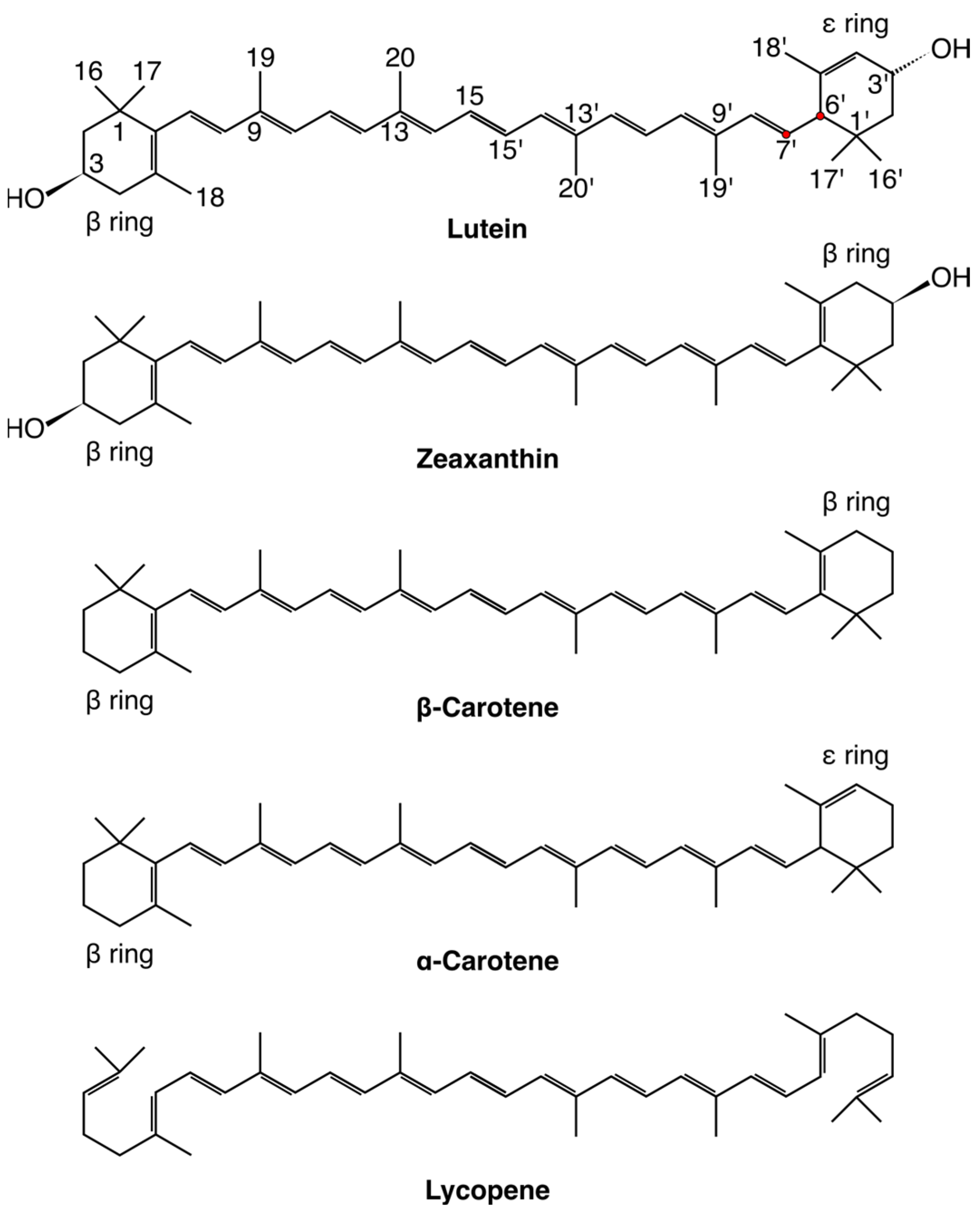
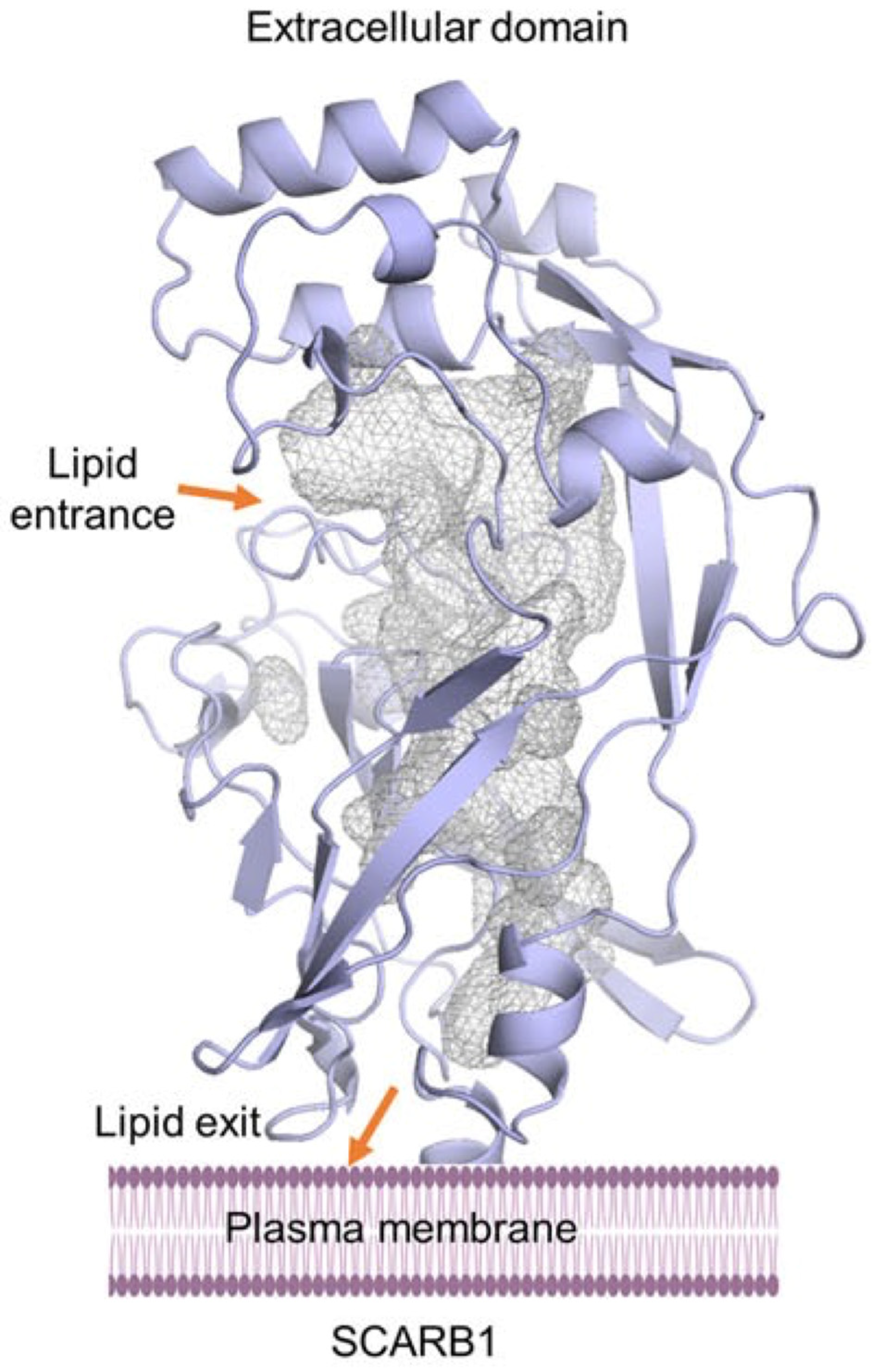
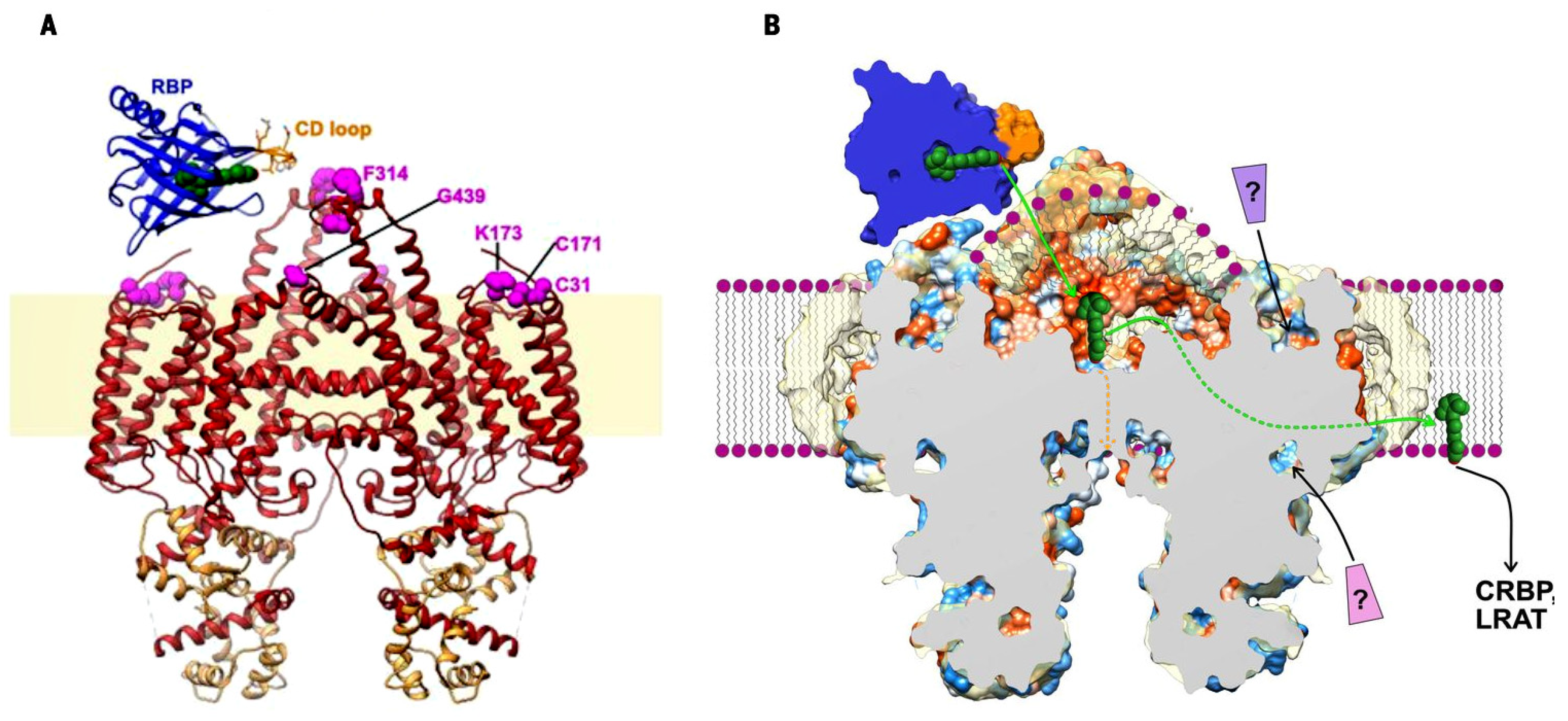
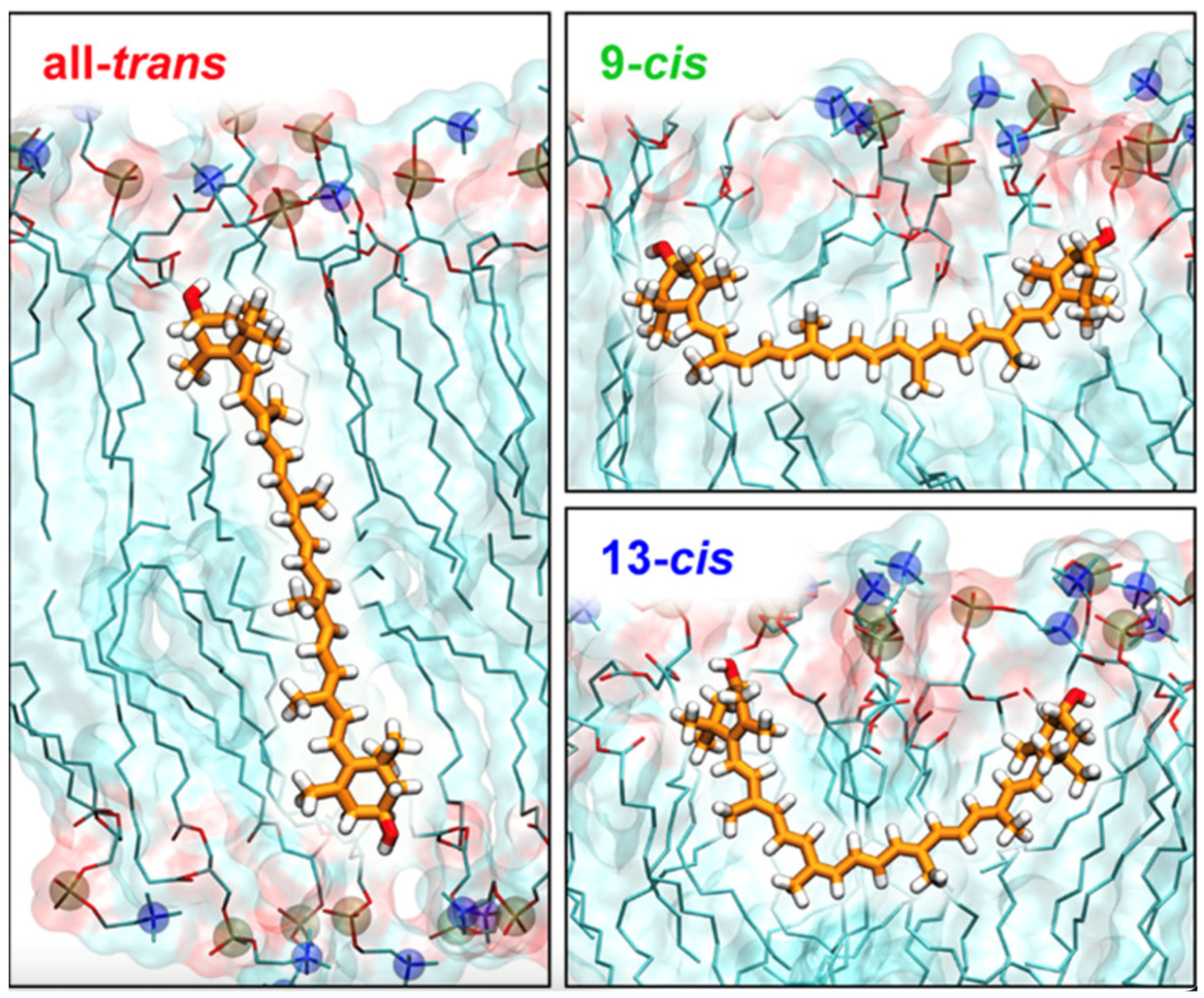
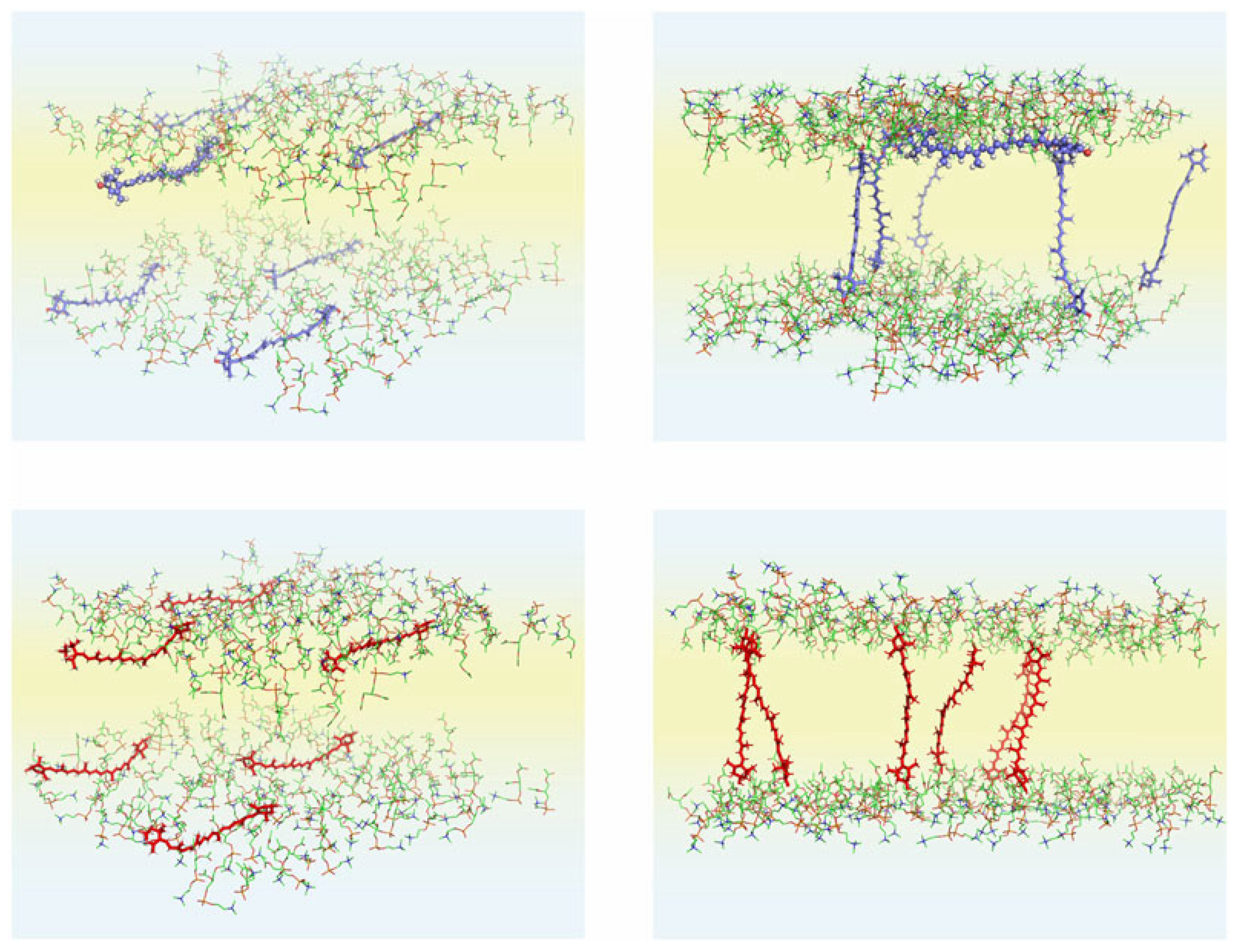
Disclaimer/Publisher’s Note: The statements, opinions and data contained in all publications are solely those of the individual author(s) and contributor(s) and not of MDPI and/or the editor(s). MDPI and/or the editor(s) disclaim responsibility for any injury to people or property resulting from any ideas, methods, instructions or products referred to in the content. |
© 2024 by the authors. Licensee MDPI, Basel, Switzerland. This article is an open access article distributed under the terms and conditions of the Creative Commons Attribution (CC BY) license (https://creativecommons.org/licenses/by/4.0/).
Share and Cite
Pasenkiewicz-Gierula, M.; Hryc, J.; Markiewicz, M. Dynamic and Energetic Aspects of Carotenoids In-and-Around Model Lipid Membranes Revealed in Molecular Modelling. Int. J. Mol. Sci. 2024, 25, 8217. https://doi.org/10.3390/ijms25158217
Pasenkiewicz-Gierula M, Hryc J, Markiewicz M. Dynamic and Energetic Aspects of Carotenoids In-and-Around Model Lipid Membranes Revealed in Molecular Modelling. International Journal of Molecular Sciences. 2024; 25(15):8217. https://doi.org/10.3390/ijms25158217
Chicago/Turabian StylePasenkiewicz-Gierula, Marta, Jakub Hryc, and Michal Markiewicz. 2024. "Dynamic and Energetic Aspects of Carotenoids In-and-Around Model Lipid Membranes Revealed in Molecular Modelling" International Journal of Molecular Sciences 25, no. 15: 8217. https://doi.org/10.3390/ijms25158217
APA StylePasenkiewicz-Gierula, M., Hryc, J., & Markiewicz, M. (2024). Dynamic and Energetic Aspects of Carotenoids In-and-Around Model Lipid Membranes Revealed in Molecular Modelling. International Journal of Molecular Sciences, 25(15), 8217. https://doi.org/10.3390/ijms25158217






